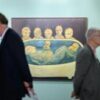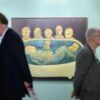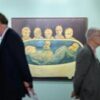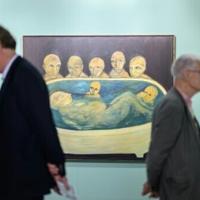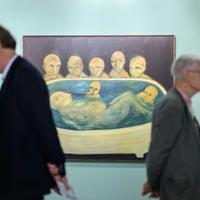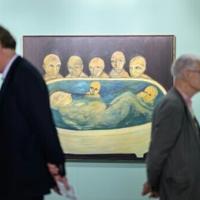
It’s raining records in the Indian art market. On Wednesday evening Tyeb Mehta’s Trussed Bull 1956 was sold for Rs 61.80 crore ($7.27 million), nearly nine times its higher estimate, creating a new record for the artist and becoming the second highest valued artwork by an Indian artist sold at auction globally.
Interestingly, it has tied with Amrita Sher-Gil’s The Story Teller, 1937, which was sold at an auction in 2023 and held the record for the highest valued work sold at auction by an Indian artist, till mid-March this year when that record was shattered by Christie’s selling Maqbool Fida Husain’s Untitled (Gram Yatra) for $13.75 million (Rs 119 crore), making it the most expensive Modern Indian painting ever sold.
Remarkably both Tyeb Mehta’s Trussed Bull 1956 and Amrita Sher-Gil’s The Story Teller 1937 were sold by Saffronart—India’s leading auction house that is celebrating its silver anniversary this year. “The outstanding result for Tyeb Mehta’s powerful portrayal of a trussed bull from 1956 is testament to his enduring influence as a cornerstone of modern Indian art—made even more meaningful in his centenary year. This auction not only underscores the strength of the South Asian art market but also its increasing global prominence,” says Dinesh Vazirani, Saffronart CEO and Co-Founder. Saffronart’s 25th Anniversary sale on Wednesday also set a world record for the highest value sale of South Asian art at an auction, achieving a total sales value of Rs 217.81 crore ($25.62 million), and concluding as a white glove, or 100%, sale. The catalogue featured many rare works, with 80% selling above their higher estimates. These included a still life by Amrita Sher-Gil titled Still Life with Green Bottles and Apples, 1932 which was sold for Rs 24 crore ($2.82 million), surpassing its higher estimate. Such a work by Sher-Gil is rare to come up for auction since she painted only a handful of still lifes during her career, with few remaining in private hands. Supper at Emmaus, 1987 by F N Souza sold for $1.8 million (Rs 15.30 crore), more than double its higher estimate. This painting depicted Caravaggio’s instrumental 17th-century painting of the same name, and is among a series of paintings centred around Biblical themes that Souza made in the 1980s.
While records are being created, art industry observers feel that the writing has been on the wall for a while now. “This isn’t new. Figures at auction and in private sales are being breached constantly. As per our data, there are dozens of records that have been shattered, year upon year over the past 14 years—though it stands out as obvious that when one witnesses a flurry of activity in rapid succession that includes the highest price being reset over the course of a short duration, it tends to attract more attention, more so now with the top-tier prices and ranks being so heavily reordered,” says Arvind Vijay Mohan, CEO, Indian Art Investor, an art market intelligence and research firm.
As per the Indian Art Investor 2024-25 Art Market Report, the turnover recorded from the sale of Indian Modern and Contemporary art at auctions globally for the year was Rs 1,016 crore. “As per our market data that covers sales conducted over the past 37 years, the market overall has recorded a CAGR that ranges between 14-18%,” says Vijay Mohan. He believes that thanks to growing patronage and a sharp ascent in the valuation of Modernists, the market will continue to grow at this rate. “Consider that Tyeb Mehta’s highest price has been reset thrice in the past 36 months, rising from Rs 36.8 crore to Rs 61.8 crore. As per our research, there is a similar consistency in the growth patterns recorded for 112 Indian artists,” says Vijay Mohan adding that in FY2024-25, all-time highest prices were recorded for 65 artists. “A clear indicator of a widening market, these include a range of artists from G Ravinder Reddy, Pilloo Pochkhanawala, Dhruva Mistry, Senaka Senanayake and Manu Parekh.”
Ashish Anand, CEO and Managing Director, DAG (formerly Delhi Art Gallery) pegs the total art market size including galleries and dealers today at around Rs 3,000 crore, an exponential growth from just Rs 15-20 crore at the turn of the century. However, he believes that true growth will come only now, with the market growing to around Rs 10,000 crore by 2030. While this may sound significant, we are miniscule compared to the global art market that is around $65 billion.
So what’s fuelling this growth? “There are several factors responsible for this development that has been recording stable growth since 2014 onwards. The first is a visible cultural evolution and a maturing audience, indicative of global exposure, and a realisation that appreciation and support for the arts — theatre, music, art, dance and the like — particularly at an institutional level is crucial,” says Vijay Mohan. “Over the past decade in particular, there have been several major announcements from India’s leading business barons and their establishment to support cultural endeavours and events,” he adds. These include the Kiran Nadar Museum of Art that is geared to open its new stand-alone museum building in the National Capital Region in 2026, and the Nita Mukesh Ambani Cultural Centre (NMACC) in Mumbai that has a four-storey dedicated art space.
There is also the changing demography of the Indian collector. Today besides the second and third generations of affluent families adding to their collections, there is a whole breed of young entrepreneurs and professionals who have the reach and disposable income to acquire art. Moreover, first time collectors are getting younger (at Saffronart nearly 40 per cent of their clientele is below 40 years) and are more attracted to contemporary art which appeals to their aesthetics as well as their pockets.
As per Vijay Mohan, Covid also played a role in expanding the art market. “It made many reassess the value of their time on this planet, and measure this against the value of their wealth. Several people came to appreciate the need to live fully following the reopening of the world, as it were. A wide level of support and connoisseurship for the arts followed.”
And what does the future of the art market look like? “Very bright,” says Anand. According to him only 4,000 art works were sold in India last year by all the auction houses combined. “4000 art works in a country of 1.4 billion people is like a drop in the ocean. This number will just keep increasing with the collector base growing, with more art fairs taking place, larger number of auctions happening. My sense is that we will be 2-3 per cent of the global art market by the end of the decade,” says Anand.
This post was originally published on this site be sure to check out more of their content

